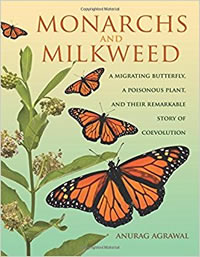 “Monarchs and Milkweed” is like a mystery novel of the highest order. Who will survive? The butterfly or the weed? Even better, this is not fiction!
“Monarchs and Milkweed” is like a mystery novel of the highest order. Who will survive? The butterfly or the weed? Even better, this is not fiction!
Anurag Agrawal’s writing is very compelling. I read the pages of his book as quickly as any whodunit. The characters include the baby caterpillar monarchs, trying to survive their first encounter with their only source of food, the leaves of milkweed. Many do not.
The milkweed plant has many ways to protect itself including its own gooey latex-like sap, or by coaxing monarch predators to do the job. There is good reason for this – the plant gains nothing from its interaction as the adult butterflies are not helpful pollinators.
In contrast, the larval and adult butterflies gain a toxicity that protects them from significant predation by birds. But this toxicity is not effective against other insects or various parasites. The plant seems to know this. The battle of coevolution moves on.
Agrawal is a scientist who interweaves his personal life and research. He discovered the caterpillar of an unknown species, brought it into his living room, watched it pupate, and then emerge from its chrysalis as a butterfly. This was a serendipitous lesson in mimicry as it was a viceroy butterfly, with similar coloration to a monarch and thereby gaining some of its protection, even though it lacks toxicity for birds.
This year’s winner of the CBHL Award of Excellence in Gardening and Gardens, “Monarchs and Milkweed” has wide appeal, even for parts of the country like ours outside of the natural range of monarchs.
Excerpted from the Summer 2018 Arboretum Bulletin.